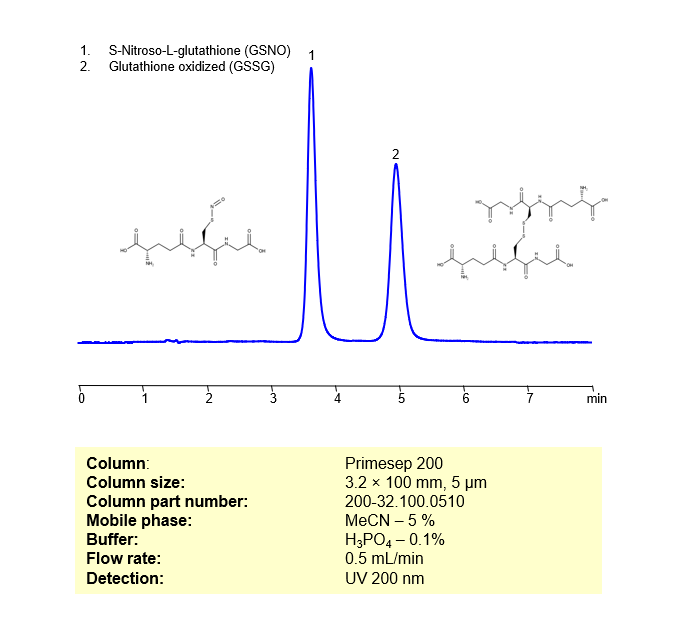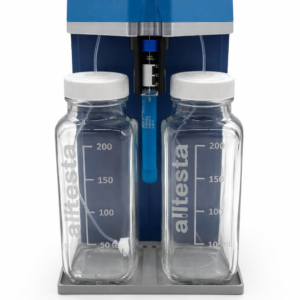HPLC Method for Separation of S-Nitroso-L-glutathione and Glutathione oxidized on Primesep 200 by SIELC Technologies
Separation type: Liquid Chromatography Mixed-mode

Both S-Nitroso-L-glutathione (GSNO) and oxidized glutathione (GSSG) are forms of glutathione, a tripeptide consisting of the amino acids glutamic acid, cysteine, and glycine. Glutathione plays a significant role in maintaining the redox (reduction-oxidation) balance in cells, but GSNO and GSSG each have unique characteristics:
- S-Nitroso-L-glutathione (GSNO): GSNO is a nitric oxide (NO) donor in cells, and it is part of the group of S-nitrosothiols. The nitric oxide group is attached to the sulfur atom of the cysteine residue in glutathione. GSNO plays a key role in nitric oxide-mediated cellular signaling and can regulate protein function through a process called S-nitrosylation.
- Glutathione, oxidized (GSSG): GSSG is formed when two molecules of glutathione (GSH, the reduced form of glutathione) are linked together by a disulfide bond (-S-S-). This typically occurs in cells under conditions of oxidative stress, when reactive oxygen species (ROS) levels are high. The enzyme glutathione reductase can convert GSSG back to GSH using NADPH as a cofactor, which is an important part of cellular defenses against oxidative stress.
Each form of glutathione plays a unique role in cell signaling and defense mechanisms. While they are related, the specific effects of GSNO and GSSG within cells can be quite different due to their distinct chemical structures and reactivities.
These compounds can be retained, separated, and analyzed using a reverse-phase Primesep 200, 3.2 x 100 mm, 5 µm, 100 A, dual ended column. The mobile phase for this method consists of water, acetonitrile (MeCN), and Sulfuric acid, which serves as a buffer. This analytical method can be
High Performance Liquid Chromatography (HPLC) Method for Analysis of S-Nitroso-L-glutathione (GSNO), Glutathione oxidized (GSSG)
Condition
| Column | Primesep 200, 3.2 x 100 mm, 5 µm, 100 A, dual ended |
| Mobile Phase | MeCN -10% |
| Buffer | H2SO4 0.2% |
| Flow Rate | 1.0 ml/min |
| Detection | UV 200, 355 nm |
Description
| Class of Compounds | Thiol, Amino acid |
| Analyzing Compounds | S-Nitroso-L-glutathione (GSNO), Glutathione oxidized (GSSG) |
Application Column
Primesep 200
Column Diameter: 3.2 mm
Column Length: 100 mm
Particle Size: 5 µm
Pore Size: 100 A
Column options: dual ended
S-Nitroso-L-glutathione (GSNO)





